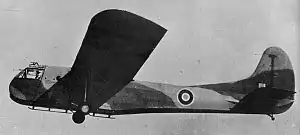No. 673 Squadron RAF
No. 673 (Apache Training) Squadron, Army Air Corps was a glider squadron of the Royal Air Force, active during the Second World War.
| 673 (Apache Training) Squadron AAC | |
|---|---|
| Active | 1 January 1945 – 25 October 1945 * April 1996 - present day |
| Country | |
| Branch |  Army Air Corps logo |
| Role | AgustaWestland Apache squadron |
| Size | 35 permanent staff, 12 Students |
| Part of | 7 (Training) Regiment Army Air Corps, Middle Wallop |
| Commanders | |
| Colonel of the Regiment | The Prince of Wales |
| Insignia | |
| Identification symbol | _Crest.png.webp) 673 (AH TRG) Crest |
History
No. 673 Squadron was formed at Bikram, Patna in (then) British India on 1 January 1945[1] as a glider squadron, with the intention of being used for airborne operations by South East Asia Command. It continued to train, as part of No. 344 Wing RAF, until the surrender of Japan, when it became surplus to requirements; the squadron was disbanded on 25 October 1945 at Kargi Road.[1]
Present
The original squadron is represented today by 673 (AH) Training Squadron of 7 (Training) Regiment, Army Air Corps.
Aircraft operated

A Waco CG-4 (Hadrian) in British service.

A de Havilland Tiger Moth restored in wartime colours.
.jpg.webp)
AgustaWestland Apache in British service.
| From | To | Aircraft | Variant |
|---|---|---|---|
| January 1945 | September 1945 | Hadrian | |
| January 1945 | September 1945 | de Havilland Tiger Moth | Mk.II |
| April 1996 | present day | AgustaWestland Apache | AH1 |
Squadron bases
| From | To | Base |
|---|---|---|
| 27 January 1945 | 19 February 1945 | Bikram, Bihar, British India |
| 19 February 1945 | 10 April 1945 | Belgaum, Karnataka, British India |
| 10 April 1945 | 26 August 1945 | Bikram, Bihar, British India |
| 26 August 1945 | 16 September 1945 | Tilda, Chhattisgarh, British India |
| 16 September 1945 | 25 October 1945 | Kargi Road, Chhattisgarh, British India |
References
Notes
- Halley 1988, p. 452.
- Jefford 2001, pp. 266–271.
Bibliography
- Bowyer, Michael J.F.; Rawlings, John D.R. (1979). Squadron Codes, 1937–56. Cambridge, UK: Patrick Stephens Ltd. ISBN 0-85059-364-6.
- Delve, Ken (1994). The Source Book of the RAF. Shrewsbury, Shropshire, UK: Airlife Publishing. ISBN 1-85310-451-5.
- Flintham, Vic; Thomas, Andrew (2003). Combat Codes: A Full Explanation and Listing of British, Commonwealth and Allied Air Force Unit Codes since 1938. Shrewsbury, Shropshire, UK: Airlife Publishing Ltd. ISBN 1-84037-281-8.
- Halley, James J. (1988). The Squadrons of the Royal Air Force & Commonwealth, 1918–1988. Tonbridge, Kent, UK: Air-Britain (Historians) Ltd. ISBN 0-85130-164-9.
- Jefford, C.G. (2001). RAF Squadrons, a Comprehensive record of the Movement and Equipment of all RAF Squadrons and their Antecedents since 1912 (2nd ed.). Shrewsbury, Shropshire, UK: Airlife Publishing Ltd. ISBN 1-85310-053-6.
- Rawlings, John D.R. (1982). Coastal, Support and Special Squadrons of the RAF and their Aircraft. London: Jane's Publishing Company Ltd. ISBN 0-7106-0187-5.
This article is issued from Wikipedia. The text is licensed under Creative Commons - Attribution - Sharealike. Additional terms may apply for the media files.